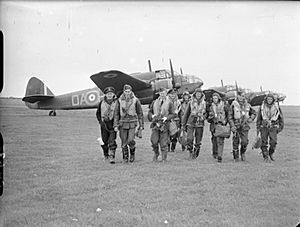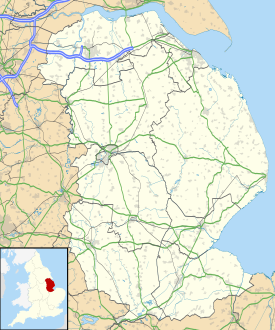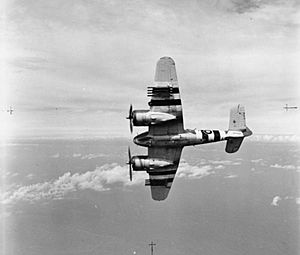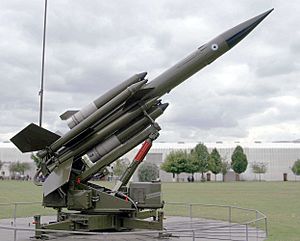RAF North Coates facts for kids
Quick facts for kids RAF North Coates
|
|||||||||||
|---|---|---|---|---|---|---|---|---|---|---|---|
| North Coates, East Lindsey, Lincolnshire | |||||||||||

Aircrew and Bristol Beaufort Mk Is of No. 22 Squadron at North Coates
|
|||||||||||
|
Location in Lincolnshire
|
|||||||||||
| Coordinates | 53°29′59.3″N 0°3′57.7″E / 53.499806°N 0.066028°E | ||||||||||
| Code | NC | ||||||||||
| Site information | |||||||||||
| Operator | Royal Flying Corps Royal Air Force |
||||||||||
| Condition | Mainly returned to agricultural use; part occupied by North Coates Flying Club | ||||||||||
| Site history | |||||||||||
| Built | 1914 | ||||||||||
| In use | 1916–1919 1926–1990 |
||||||||||
| Fate | Sold to private ownership | ||||||||||
| Battles/wars | First World War Second World War |
||||||||||
| Garrison information | |||||||||||
| Occupants | See list below | ||||||||||
| Airfield information | |||||||||||
| Identifiers | ICAO: EGYO | ||||||||||
| Elevation | 17 ft (5.2 m) AMSL | ||||||||||
|
|||||||||||
Royal Air Force North Coates or RAF North Coates was a military air base in Lincolnshire, England. It was located about six miles south-east of Cleethorpes, near the mouth of the Humber estuary.
This air base was very active during the First World War. It was used again from the mid-1920s. During the Second World War, from 1942 to 1945, it was home to a special group of planes called a Coastal Command Strike Wing. Later, from 1958, it became a base for Bloodhound surface-to-air missiles. RAF North Coates finally closed in 1990.
Contents
RAF North Coates in the First World War
The camp at North Coates Fitties first opened in 1914. Soldiers from the Lincolnshire Regiment were based there. In 1916, it became a landing spot for planes from the Royal Flying Corps. This was a very early version of the Royal Air Force.
Planes from No. 33 (Home Defence) Squadron used it. Their job was to fly patrols along the coast of North Lincolnshire. After the war ended in November 1918, the airfield slowly closed down. By March 1919, it was completely shut, and the land was given back to its original owner.
Between the World Wars
The site was bought again in 1926. It was used as a base for planes that needed to practice bombing at the nearby Donna Nook range. It was called No. 2 Armament Practice Camp.
From 1936 until the start of the Second World War, the base also trained people. They learned how to be observers (who spotted things from the air) and air gunners (who fired guns from planes).
RAF North Coates in the Second World War
When war was declared on September 3, 1939, the training groups moved away. New groups were formed at the airfield. These included No. 2 Recruit Training Pool and the Ground Defence Gunnery School.
In February 1940, the base became part of Coastal Command. This part of the RAF protected ships and coastlines. Squadrons like No. 235, 236, and 248 used the base. They flew Blenheim planes, which could be used as bombers or long-range fighters. Over the next two years, many different Coastal Command squadrons used North Coates. These included RAF, Fleet Air Arm (Navy planes), and Royal Canadian Air Force units. They flew various planes, such as Beaufort and Hudson bombers, Hampden and Swordfish torpedo planes, and Avro Anson reconnaissance planes.
The North Coates Strike Wing
In September 1942, North Coates became the home of the North Coates Strike Wing. This was a special group made up of three squadrons: 143, 236, and 254. They flew Beaufighter planes. These planes were used as heavy fighters, bombers, and "Torbeaus" (torpedo bombers). Their main job was to attack enemy ships in the North Sea.
The Strike Wing's first mission was on November 20, 1942. Beaufighters from 236 and 254 Squadrons took off to attack a group of twelve to sixteen ships. The weather was bad, and enemy Fw 190 fighters protected the ships. Only three enemy ships were damaged. Sadly, three Beaufighters were shot down, and four more were badly damaged.
After this, the Strike Wing stopped missions for a while to train hard. During this time, between late 1942 and early 1943, a new concrete runway was built.
Their second mission was on April 18, 1943. Nine "Torbeaus" from 254 Squadron, six Beaufighter bombers from 236 Squadron, and six Beaufighter heavy fighters from 143 Squadron attacked a convoy. Spitfires and Mustangs provided air cover. The Beaufighters attacked the escort ships with bombs and machine guns. The "Torbeaus" attacked the largest merchant ship. Two German minesweepers were set on fire, and a trawler was damaged. Two torpedoes hit the merchant ship, leaving it listing and on fire. This attack lasted only 15 minutes, and only a few planes had minor damage.
Another mission later that month sank two merchant ships and a trawler. Several escort ships were damaged, and only one Beaufighter was lost. In June, the Strike Wing started using RP-3 rocket projectiles. By the middle of the year, they had made the Port of Rotterdam almost unusable for enemy ships. Ship captains bringing iron ore from Sweden started asking for huge bonuses because of the danger.
By the end of 1943, the Strike Wing had sunk thirteen ships, totaling over 34,000 tons. By the end of the war in May 1945, they had sunk over 150,000 tons of shipping. They also sank two U-boats (German submarines): U-418 in June 1943 and U-2338 in May 1945. However, they lost 120 aircraft and 241 aircrew during their operations.
- The RAF North Coates Strike Wing War Memorial in Cleethorpes
After the War
North Coates closed in August 1946. It became a storage site for aircraft parts. In January 1947, it became No. 1 Initial Training School. However, the base was very isolated during the severe winter of 1947. Because of this, the Officer Cadets (trainees) were soon moved.
In May 1948, it became home to the School of Explosives Inspection. It also housed No. 5131 Bomb Disposal Wing. In January 1953, the airfield was flooded during the North Sea flood. It was temporarily abandoned because the water was about three feet deep.
In August 1953, the base became home to No. 54 Maintenance Unit. Their job was to break down old and crashed aircraft for spare parts. Between 1955 and 1957, "B" Flight of No. 275 (Air Sea Rescue) Squadron used the base. They flew Bristol Sycamore HR.14 helicopters to rescue people.
In April 1956, North Coates was chosen to be the RAF's first base for Surface to Air Guided Weapons. These were Bloodhound surface-to-air missiles. Forty-eight of these missiles were kept there. Work began in July 1956 to build the missile facilities. This included missile pads, a control center, and repair hangars.
The Bloodhound missiles stayed at North Coates until mid-1990. The base finally closed in December 1990. The site was then sold to private owners.
In April 1992, the entire airfield and buildings were sold. Over the next eight years, the houses were sold. New uses were found for many buildings, like the Station HQ and accommodation blocks. In 1999, the airfield and related land were sold to a local farmer. He turned most of the airfield back into farmland. The concrete runway and taxiways were removed. One hangar is still used by the North Coates Flying Club. They have a grass airstrip where the old runway used to be.
In May 2020, a plane wreck was found on Cleethorpes beach. It is believed to be a Beaufighter plane, JM333, from No. 254 Squadron. The plane had to land in the sea on April 21, 1944, shortly after taking off from North Coates. Both engines had failed, but the crew survived without injury.
Squadrons that used the base
| Dates | Name | Notes |
|---|---|---|
| 1914 – 1916 | Lincolnshire Regiment | |
| 1916 – September 1918 | No. 33 Squadron RFC/RAF | Used Royal Aircraft Factory B.E.2 planes. |
| October 1918 – March 1919 | No. 248 Squadron RAF | Used Airco DH.6, Sopwith Baby and Sopwith Tabloid planes. |
| Closed March 1919 – 1926 | ||
| February 1927 – October 1936 | No. 2 Armament Practice Camp | Later renamed No. 2 Armament Training Camp. |
| January 1936 – 2 September 1939 | Air Observers School | Trained air observers. |
| 1934 – July 1945 | North Coates Station Flight | Had various planes like Fairey Gordon and Westland Wallace. |
| 9 April 1938 – 7 May 1938 | No. 144 Squadron RAF | Flew Bristol Blenheim Mk I. |
| September 1939 – June 1940 | No. 2 Recruit Training Pool | |
| December 1939 – June 1940 | Ground Defence Gunnery School | Used planes like Westland Wallace and Hawker Hart. |
| January 1940 – August 1940 | Detachment, No. 611 Squadron RAF | Flew Supermarine Spitfire Mk I. |
| February 1940 – April 1940 | No. 248 Squadron RAF | Flew Bristol Blenheim IVF. |
| February 1940 – April 1940 | No. 235 Squadron RAF | Flew Bristol Blenheim Mk IA & IVF. |
| February 1940 – April 1940 | No. 236 Squadron RAF | Flew Bristol Blenheim Mk IA & IVF. |
| April 1940 – June 1941 | No. 22 Squadron RAF | Flew Bristol Beaufort Mk I, Avro Anson Mk I and Martin Maryland. |
| May 1940 – March 1941 | 812 Naval Air Squadron | Flew Fairey Swordfish. |
| August 1940 – February 1941 | Detachment, No. 616 Squadron RAF | Flew Supermarine Spitfire Mk I. |
| March 1941 – May 1941 | 816 Naval Air Squadron | Flew Fairey Swordfish. |
| May 1941 – December 1941 | No. 86 Squadron RAF | Flew Bristol Beaufort Mk I. |
| June 1941 | No. 6 Anti Aircraft Co-operation Unit | Used de Havilland DH.87 Leopard Moth and Westland Lysander. |
| July 1941 – February 1942 | No. 407 Squadron RCAF | Flew Lockheed Hudson Mk V. |
| November 1941 – January 1943 | "D" Flight, No. 278 Squadron RAF | Used Westland Lysander and Boulton Paul Defiant ASR Mk. 1. |
| January 1942 – August 1942 | No. 59 Squadron RAF | Flew Lockheed Hudson Mk V and two Consolidated B-24 Liberator Mk III. |
| January 1942 – May 1942 | No. 53 Squadron RAF | Flew Lockheed Hudson Mk I & V. |
| February – March 1942 | 776 Naval Air Squadron | Flew Blackburn Roc. |
| February 1942 – November 1943 | No. 7 Anti Aircraft Co-operation Unit | Used Westland Lysander, Miles Master, and Airspeed Oxford. |
| April – May 1942 | No. 42 Squadron RAF | Flew Bristol Beaufort Mk I. |
| June – August 1942 | No. 415 Squadron RCAF | Flew Handley Page Hampden TB Mk I. |
| August 1942 – August 1943 | No. 143 Squadron RAF | Flew Bristol Blenheim Mk IV and Bristol Beaufighter Mk IIF. |
| September 1942 – October 1942 | Detachment, No. 608 Squadron RAF | Flew Lockheed Hudson Mk V. |
| September 1942 – May 1945 | No. 236 Squadron RAF | Flew Bristol Beaufighter. |
| November 1942 – June 1945 | No. 254 Squadron RAF | Flew Bristol Beaufighter, de Havilland Mosquito Mk XVIII, a Bristol Beaufort and an Avro Anson. |
| January – March 1944 | No. 415 Squadron RCAF | Flew Vickers Wellington XIII. |
| February – May, & September 1944 | No. 143 Squadron RAF | Flew Bristol Beaufighter, a Bristol Blenheim and a de Havilland Mosquito. |
| September – October 1945 | No. 25 Maintenance Unit | |
| October 1945 – December 1946 | No. 61 Maintenance Unit | |
| January – October 1947 | No. 1 Initial Training School | |
| May 1948 – August 1953 | ||
| July 1948 – August 1953 | No. 5131 Bomb Disposal Wing | |
| August 1953 – July 1956 | No. 54 Maintenance Unit | |
| Mid-1954 – June 1990 | RAF North Coates Station Flight | Flew Avro Anson. |
| November 1954 – October 1957 | "B" Flight, No. 275 (Air Sea Rescue) Squadron RAF | Flew Bristol Sycamore HR.14. |
| December 1958 – November 1962 | No. 264 Squadron RAF | Used Bristol Bloodhound Mk I missiles. |
| February 1962 – December 1966 | No. 17 Joint Services Trials Unit | Used Bristol Bloodhound Mk II missiles. |
| February 1963 – April 1964 | No. 148 (SAM) Service Wing | Used Bristol Bloodhound Mk I missiles. |
| October 1963 – January 1971 | No. 25 Squadron RAF | Used Bristol Bloodhound Mk I, later Mk II missiles. |
| October 1963 – August 1964 | Surface to Air Missile Operational Training School | Used Bristol Bloodhound Mk II missiles. |
| March 1976 – April 1990 | "B" Flight, No. 85 Squadron RAF | Used Bristol Bloodhound Mk II missiles. |
| April 1987 – June 1990 | Bloodhound Missile System Maintenance School | Used Bristol Bloodhound Mk II missiles. |
See also
- List of former Royal Air Force stations




